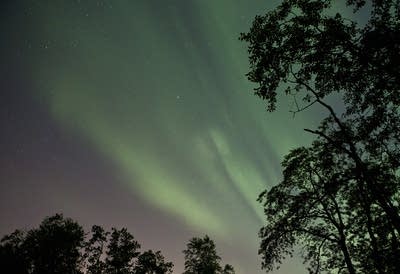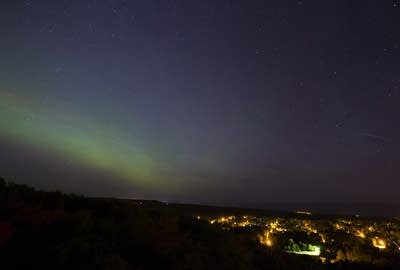Boundary Waters designated a dark sky sanctuary

Go Deeper.
Create an account or log in to save stories.
Like this?
Thanks for liking this story! We have added it to a list of your favorite stories.
Anyone who’s spent the night in the Boundary Waters Canoe Area Wilderness already knows that the night sky overhead is spectacular.
"The Milky Way just fills the sky. It literally is a river of stars,” said Joel Halvorson, a consultant and science educator. He lives part time along the Gunflint Trail in far northeastern Minnesota, just outside the wilderness.
Now, the whole world will know what tens of thousands of paddlers have already discovered.
Late last month the Boundary Waters was named a dark sky sanctuary by the International Dark Sky Association, a nonprofit that works around the world to reduce light pollution and protect night skies. It's one of just 13 such designations in the world.
Turn Up Your Support
MPR News helps you turn down the noise and build shared understanding. Turn up your support for this public resource and keep trusted journalism accessible to all.
To qualify, a place has to have exceptional starry nights, and a “nocturnal environment that is protected for its scientific, natural or education value, its cultural heritage and/or public enjoyment.”
Other examples include Great Barrier Island in New Zealand and Rainbow Bridge National Monument in Utah. The designation is designed to increase awareness of these fragile sites and promote their long-term conservation.
To prove that the Boundary Waters merits the distinction, Ann Schwaller, BWCA program manager for the Superior National Forest, spent several days over the past two years traveling into the wilderness with what’s called a sky quality meter. It’s a special tool to measure the darkness.
"It's just this little teeny meter, and you have to point it straight to the sky,” she explained, during a new moon. “So as dark as possible."
Schwaller and others took many different readings over several months during 2019 and 2020. They’ll continue to measure the darkness annually in order to renew the certification.
Schwaller has led the push for dark sky designation for the Boundary Waters since 2008. A big part of her job is to help preserve the wilderness character of the BWCA: its solitude and silence, and also, its largely unspoiled night sky. She said working on this project has heightened her appreciation of its nighttime vistas.
"This is a dark sky heritage. We're looking at a sky that people looked at thousands of years ago. And to me it feels like preserving a really special heritage. It's part of the fabric of the Boundary Waters."
Schwaller said the new designation will help the Forest Service protect the Boundary Waters' dark skies for future generations by adding another level of consideration when analyzing future proposed projects that could impact the night sky.
It will also likely help draw more tourists to the region. They’re known as “astrotourists” — people who travel to view and photograph the stars and the northern lights.
Two years ago Cook County tourism officials launched a Dark Sky Festival in Grand Marais to promote the region's night sky. They've had an uptick in visitors coming to the North Shore specifically to see the stars and the northern lights, said Visit Cook County executive director Linda Jurek.
While there are many places in the western U.S. recognized for their dark skies, the region over the Boundary Waters is the only site in the eastern U.S. with darkness that ranks as Level 1 on something called the Bortle Scale. It is named for an astronomer who devised a system of ranking the quality of night skies from one to nine.
“It's estimated about 85 percent of the world's population lives in a place where they cannot see the Milky Way," said Joel Halvorson, who has brought a portable planetarium and other educational materials to the Dark Sky festival and other events in northeastern Minnesota.
"Oftentimes children, you bring up the Milky Way and they'll say, ‘that's a candy bar, right?’ It's kind of sad. We take it for granted, if you grew up seeing it as children, or if you've gone camping or gone outside of city lights.”
The Superior National Forest is part of a broader, international effort to recognize and protect the dark skies over the Minnesota-Canada border.
Voyageurs National Park, along with Quetico and La Verandrye Provincial Parks in Ontario, are also pursuing dark sky designations. The goal is to create one of the world’s largest dark sky destinations.
Nature photographer Travis Novitsky, who grew up on the Grand Portage reservation, knows he’s privileged to be able to walk out his backdoor and see the Milky Way, or the aurora borealis.
He’s been photographing the night sky for 20 years, and said he’s been drawn to it since he was a kid.
"Experiences like hearing a moose walk through the woods as I'm staring at the Milky Way, or just sitting on a rock next to the shoreline and basically kind of naturally getting into this meditative state by just sitting there and taking in this incredible view of stars — more stars than you can comprehend."





